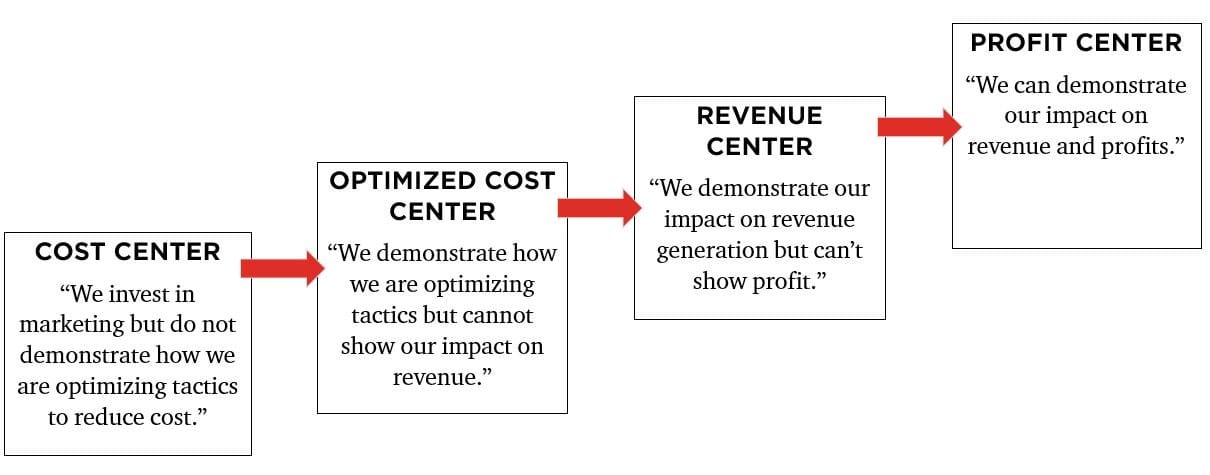Current Focus for Marketing Leaders
The past several years there has been an increased focus on the need for better performance-based measures in marketing. Most importantly - marketing’s ability to prove the impact it’s making on the business in terms of sales attribution. As a result, terms like “revenue marketing” were coined, books were published and thought leaders emerged. In 2017 we saw widespread acceptance and adoption around this approach to marketing.
The main objective of revenue marketing is to align with sales operations so marketing can take on more ownership of sales pipeline development and acceleration. Aside from investments in tech, people, and processes, it requires a very tight-knit alignment with the sales team. Not only does marketing and sales alignment improve marketing performance, but it also helps marketers prove the impact their making on revenue; something that has been a known challenge for marketing leaders.
Aside from alignment with sales, we’ve also recently seen the focus move toward customer experience (CX)transformation. By placing the customer at the center of your efforts, you can architect better experiences. This can drive stronger brand loyalty and allows you to attract and grow a new customer base. Based upon this focus, a lot of investments have been made to fund better CX programs as well as acquire new technology. This has been a major strategic focus across all industries.
Although both of these areas are extremely important, Gartner’s recent prediction has some interesting implications for marketing executives:
"By 2022, profitability will replace customer experience (CX) as the CMO's number one strategic priority."
Gartner’s report also predicts a reduction in investments for marketing-funded CX programs. They predict investments will drop by at least 25%. Why the big change? Not surprisingly, Gartner attributes this to inflated investments for customer experience the last several years. As it turns out, expectations from these types of investments are not being met which is leading to executive scrutiny. (Sound familiar? The same thing is occurring in the martech space with investments made in platforms and tools.) It doesn’t mean that customer experience isn’t important nor impactful. It means that marketing leaders still can’t prove its value to their business.
I found it particularly interesting that Gartner’s prediction focuses on profit (not revenue) because revenue marketing operations is still a very hot topic in the industry. Many organizations are making the shift from cost centers to revenue centers. According to Gartner’s prediction, the shift will go even one step beyond that, indicating that marketing teams will be operating as a profit center. The shift from revenue to profit presents a whole new set of challenges to overcome.

Understanding the Next Strategic Challenge
The good news is that most organizations do currently operate in this second stage (optimized cost center), with more mature marketing organizations operating in the third stage (revenue center). Additionally, there are some organizations currently making strides in operating in the fourth stage (profit center). These are the forward-thinking marketing leaders who will be helping to shape guidelines for others to follow. That being said -if you’re not currently running rockstar revenue marketing operations, no need to get discouraged. You are not alone. One thing that is very important to keep in mind though, is that you should take some steps now to be better equipped to adapt to these changing expectations. Even if you don’t expect being placed under pressure by the executives at your own organization, it’s still a good idea to stay educated on these shifting approaches to stay relevant.
So, what can you do now?
Open the door to conversation with your organization’s CFO. There is a lot of value in aligning with finance, yet for some reason or another only 15% of marketing leaders report that they have a collaborative relationship.
It’s important to invest in building these relationships now because the CFO is an underutilized ally that can support you with immediate needs such as securing budgets. They can also assist you in demonstrating the return of marketing investments and programs in terms of revenue. Even better, based on recent surveys, the finance department has similar goals for alignment with the marketing department. Therefore, it’s very likely they’ll be receptive to requests to collaborate more.
Understanding your organization’s finance team more will give you the potential to learn new things such as how your firm accounts for things like marketing assets, branding, or even marketing activities and programs. One thing to keep in mind is that stronger alignment is not a quick fix, and there isn’t a one-size-fits-all solution. If you make the effort now to get a stronger understanding of finance, you’ll have a partner to lean on to prove marketing’s value to the business.


